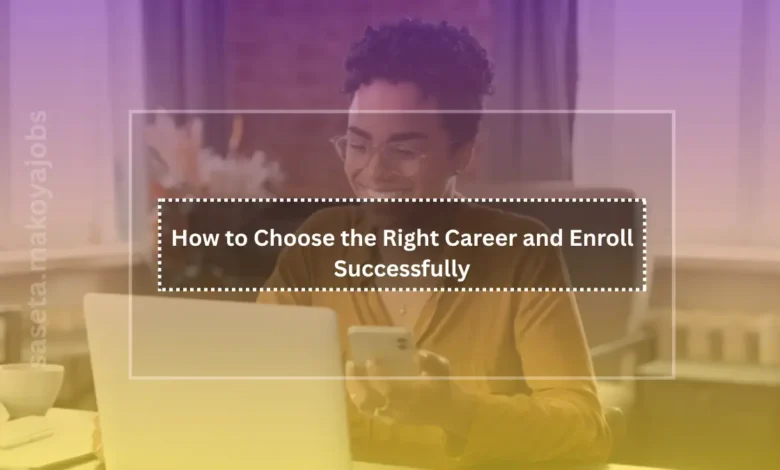Crafting a Career Strategy: How to Choose the Right Career and Enroll Successfully

Discover a step-by-step strategy to choose the right career and successfully enroll in a programme that fits your goals.
Choosing a career and enrolling in a programme that matches your interests, skills, and values is a pivotal life decision. With the rapidly shifting job market in South Africa and around the world, a structured strategy helps you choose well—then act.
This guide walks you through a five-stage strategy to clarify your best career path and ensure a successful enrolment in the right programme.
1. Discover Your Interests and Strengths
Self-Reflection
Invest time in answering:
- What subjects or tasks energize me?
- What skills come naturally—writing, organizing, problem solving?
- Which industries or causes excite me?
Tools to Help
- Personality and skills assessments (e.g. MySkillsMyFuture, online quizzes)
- Feedback from mentors or family on your strengths
- Journaling recent happy activities to identify patterns
Outcome: A shortlist of 3–5 career areas that align with your interests and natural strengths.
2. Research In-Demand Careers and Future Trends
Explore Career Prospects
Take your shortlist and research:
- Job market demand: sectors hiring now or projected to grow
- Typical salary ranges, entry-level expectations, working conditions
- Looking at National Skills Development plans or SETA insights helps (e.g. digital skills, healthcare, engineering, agriculture, retail).
Career Fit Assessment
Ask yourself:
- Do required qualifications or costs fit my budget/time?
- Are there structured learnerships, bursary opportunities, or internships?
- Will this path satisfy me long-term?
Outcome: A refined selection of educated career options, ranked by interest, feasibility, and future promise.
3. Select the Right Programme or Learning Path
Compare Programme Types
Various pathways can lead to a career:
- SETA learnerships (accredited, mix of training + paid placement)
- TVET college courses or private diplomas
- University or higher education
- Online certification programmes
Quick Comparison Table
| Pathway | Time | Cost | Workplace Exposure | Accreditation |
|---|---|---|---|---|
| SETA Learnership | 12–24 mo | Low or stipend | Paid work placement | NQF certificate |
| TVET Diploma | 12–24 mo | Medium | Practical training | NCV/NQF diploma |
| University Degree | 3–4 years | Higher | Internship optional | Degree |
| Online Course | Months | Varies | Soft evidence of skill | Certificate |
Evaluate Entry Requirements
Check if you meet:
- Age or citizenship eligibility (for SETA programmes)
- Academic requirements (Matric, specific grade pass)
- Financial or logistical constraints
Outcome: A clear path to pursue—such as enrolling in a learnership, college course, or degree programme that best matches your criteria and capacity.
4. Prepare Your Application Package
Gather Essential Documents
- Certified copy of ID (recently stamped)
- Matric certificate or equivalent
- CV highlighting relevant skills or volunteer experience
- Proof of residence
- Motivation letter tailored to the programme (especially for learnerships and bursaries)
Tailor Submissions to Criteria
- Customize your CV or motivations for each programme
- Use keywords from the programme description (e.g. “customer service,” “logistics,” “IT support”)
- Submit all required forms per instructions (correct file naming, format, etc.)
Develop a Tracking System
Use a simple spreadsheet to track:
- Programme name, provider, application link
- Submission deadline
- Documents sent
- Status updates or feedback received
Outcome: A well-prepared, organized application ready for multiple programmes if needed.
5. Seek Support and Navigate Interviews or Assessments
Mentorship and Advice
- Ask teachers, former employers, or community leaders to review your CV or motivation letter
- Attend open days, expos, or online webinars to gather information
Prepare for Interviews or Tests
- Practice explaining why you chose the field and what you bring
- Review basic literacy, numeracy, or sector-specific knowledge
- Dress appropriately and arrive early for face-to-face or online assessments
Follow-Up
- Always send a polite thank-you after interviews
- If deadlines pass without feedback, professionally follow up via email or phone
Outcome: Strong interview readiness and professional communication can set you apart from other applicants.
Going Beyond Enrollment: Settling Into Your Career Path
During Your Programme:
- Keep attendance prompt and consistent
- Be proactive: volunteer for tasks, ask questions
- Maintain a logbook or record of tasks and learning moments
- Network with supervisors, peers, and industry contacts
Near Completion:
- Reflect on your experience and how it aligns with your original goals
- Explore possible employment with your provider or related employers
- Consider advanced training or further studies to build on your foundation
Outcome: Career clarity and a growth mindset that carries beyond your initial programme.
Common Pitfalls and How to Avoid Them
| Pitfall | Why It Happens | How to Avoid It |
|---|---|---|
| Choosing based on pay only | Attraction to high salary sectors | Balance purpose, interest, stability, and scope |
| Missing deadlines or documents | Disorganization or poor tracking | Use checklists and reminders |
| Generic applications | Reusing one CV or letter for all programmes | Tailor every application to the opportunity |
| Lost motivation or overwhelmed | Waiting without follow-up or backup plans | Keep applying to multiple options; stay proactive |
| Choosing programme based on peers | Peer pressure or misinformation | Choose what fits your values, not expectations |
Final Thoughts and Inspiring Takeaway
Choosing the right career and enrolling in the right programme takes clarity, strategy, and perseverance. By understanding your interests, evaluating real-world demand, preparing targeted applications, and following through with diligence, you greatly enhance your chances of success.
Keep refining your goals, stay organized, and remember: the path is as important as the destination. Your career isn’t just a job—it’s a growing journey that starts with one intentional step.





